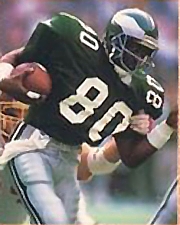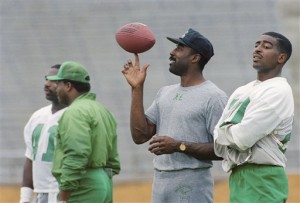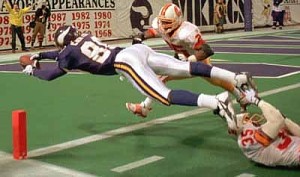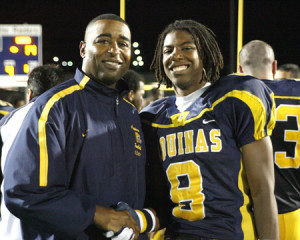Cris Carter’s Long Journey Ends in the Hall of Fame

Though best remembered for his years as a Viking, Carter started his career with three seasons as a member of the Philadelphia Eagles.
When I met Cris Carter in July 1989 there was little doubt that he had the ability to one day be a Hall of Fame wide receiver. However, after spending six months around him during the 1989 season I would have put his chances of actually ever living up to that potential somewhere between none and less than none.
So, it is quite amazing (and a testament to how people can change) that 24 years later Carter will indeed be inducted into the Pro Football Hall of Fame this weekend in Canton, Ohio.
Talent was never the problem for Carter. The brother of former Indiana University and NBA player Butch Carter, Cris was a great multi-sport athlete and heavily recruited as both a basketball and football player.
An Ohio native, he chose to stay in state and attend Ohio State University. Originally Carter planned on playing both sports in college, but after setting a Rose Bowl record with nine catches for 172 yards during his freshman year, he decided to concentrate on football.
By his junior season in 1986 Carter was a consensus All-American and had already set the Ohio State record for career receptions.
However, as a harbinger of things to come, Carter was declared ineligible for his senior season after it was discovered that he had signed a contract with sports agent Norby Walters.
Allowed to enter the NFL through a supplemental draft, Carter was selected in the fourth round by the Philadelphia Eagles.
Under the direction of colorful head coach Buddy Ryan and sporting an exciting roster of young stars including Reggie White, Randall Cunningham, Jerome Brown, Mike Quick and Keith Byars, the Eagles were a team on the rise. As a rookie, the 21-year-old Carter saw very limited action during the strike-shortened season. He played in nine games and caught five passes for 84 yards and two touchdowns.
The next season he moved into the starting lineup and was a key performer on an Eagles team that won the NFC East and reached the playoffs for the first time since the 1981 season. Carter caught 39 passes for 761 yards (19.5 ypc) and six touchdowns.
By 1989, Carter seemed to be on a path to greatness, but few realized that he was actually on a path to self-destruction.
It was at that time during the summer of 1989 that I joined the Eagles as a Public Relations intern fresh out of college at James Madison University, where I had worked in the school’s sports information office and covered the football team for the school newspaper.
Spending the season as an intern with an NFL team was a dream come true, but while most of the Philadelphia players were great to work with, dealing with Carter was often more of a nightmare.
Unbeknownst to most of his teammates (or PR interns), it turns out that while Carter acted with great confidence (some would call it cockiness) on the field and in the locker room, he was actually losing a personal battle with substance abuse.
In hindsight, it actually makes sense that Carter was dealing with such demons. When I would make my daily trips to the locker room, you never knew which Carter you were going to run into. Sometimes he was engaging, friendly and helpful, however, more often he was difficult, condescending and just plain mean.
As a 22-year-old from a rural part of Virginia, I had never dealt with anyone who was an alcoholic or drug addict, so while others may have been aware of his problems, I was completely naïve and just trying to fit into the professional world and eventually handled it by only going near him when I needed to as part of my job.
On the field in 1989 Carter became the “touchdown maker” for the Eagles. He caught 45 passes for 605 yards and 11 touchdowns. However, after catching eight passes for 113 yards in a Monday Night Football loss to the Chicago Bears in the fourth week of the season, he never caught more than four passes in a game the remainder of the season.

This picture does a great job epitomizing Carter’s time with the Eagles. Mike Quick, spinning the football, was on a Hall of Fame track before injuries derailed his career. At this point in his own career, Carter’s HOF dreams were being derailed by other things.
While Carter’s battles with drugs and alcohol were not widely publicized, at some point they became noticeable to the Philadelphia front office.
Though he had been a starting receiver for the previous two seasons and unquestionably had the potential to be a star, Ryan made the tough decision to release Carter during the 1990 training camp. While he wasn’t released until prior to the start of the season, Ryan and the Eagles seem to have known for a while that Carter wasn’t someone they could count on.
After drafting defensive back Ben Smith in the first round of the 1990 draft, they used their next three picks on wide receivers. Two of them, Fred Barnett and Calvin Williams, ended up being solid receivers, though neither was at the same talent level as Carter.
By the time Carter was waived by the Eagles I was no longer in Philadelphia and had a full-time job as the Sports Information Director at a college in Virginia. However, I remember being a little surprised when Carter was released because there was no question he was a great player, but also thinking that he was getting what he deserved.
Claimed off waivers by the Minnesota Vikings, Carter at this point had two path choices. He could have continued down the road of alcohol and drug abuse and eventually ended up a sad footnote in NFL history. Or, he could start taking personal accountability for his actions, something I don’t think he really had done throughout his collegiate and professional careers, and make some tough choices and changes.
Thankfully, Carter chose the second option and as they say, the rest is history.
Carter has said in several recent interviews that it was the jolt of being released by the Eagles that changed his attitude and eventually his life and career.
During his first season in Minnesota Carter was used primarily as a backup to star receiver Anthony Carter and starter Hassan Jones. He caught 27 passes for 413 yards and three touchdowns. Ironically, his best performance of the season came against the Eagles on Monday Night Football when he caught six passes for 151 yards, including a 78-yarder in a 32-24 loss in Philadelphia.
By 1991, Carter was on the fast track to NFL stardom. He supplanted Anthony Carter (no relation) as the top receiver on the Vikings and led the team with 72 catches for 962 yards and five touchdowns.
In 1993 Carter made his first Pro Bowl appearance while starting a streak of eight straight years with at least 78 catches and a thousand receiving yards.
He was a first team All-Pro while leading the NFL with 122 receptions in 1994. The following season Carter caught a career-high 17 touchdown passes to start a streak of five straight seasons with double digit touchdowns.
Over the remainder of the decade, Carter was among the top receivers in the NFL and was selected to eight straight Pro Bowls from 1993-2000.
In 1997 Carter’s former quarterback in Philadelphia, Randall Cunningham, joined the team as a backup to starter Brad Johnson.
The following season, Cunningham became the starter and the Vikings also added an electric new receiver in Randy Moss. With one of the most potent offenses in NFL history, the Vikings blew through the regular season with a 15-1 record.
They appeared destined to reach the Super Bowl before suffering a dramatic loss to the Atlanta Falcons in the NFC Championship Game. The Vikings had led by a touchdown in the fourth quarter and were poised to take a 10-point lead until kicker Gary Anderson missed a field goal for the first time all season. Atlanta rallied to tie the game and then won in overtime to snatch the Super Bowl trip away from Carter and his shocked teammates.
In 2000 at the age of 35, Carter caught 96 passes for 1,274 yards and became only the second receiver in NFL history to eclipse the 1,000 reception mark. He played one more season with the Vikings and then retired after playing in five games for the Dolphins in 2002.
While his performance on the field during his years with the Vikings was quite impressive, what was even more noteworthy was his change off the field.
No longer dependent on drugs or alcohol, Carter developed into an NFL role model and in 1999 was honored as the winner of the Walter Payton Man of the Year Award.
Since retirement, Carter has been a regular on ESPN as an NFL pregame analyst and also serves as an assistant coach at St. Thomas Aquinas High School in Miami, where his son Duron played before going on to play at Ohio State and Alabama.
Though I have not had the opportunity to personally see the “changed” Cris Carter, I have been able to watch his transformation while enjoying his work as a TV analyst. Occasionally I struggle with the memories that he was one of the few players that I really didn’t enjoy working with during my amazing year working in the NFL, but realize that much has changed for all of us over the last 24 years and am very pleased that he was able to turn around his life and reach his full potential.
I am also pleased that Carter will finally be taking his rightful place in the Pro Football Hall of Fame. There is no question that his on-the-field performance is HOF worthy and he has come a long way personally to reach this pinnacle.
I look forward to hearing what I am sure will be an inspirational and self-reflective speech by someone who I now can say that I am proud to have once worked with.


Johnny Depp is another example of a celebrity who loves stylish sunglasses.
You are only recommended to use this type of
dress as long as your body allows it. It could possibly be employed generally because of development kind as well
as excellent best quality.
My web site – bandage wedding dress knee length
Thus we became noobs on the water when we purchased our 1957 Sea King
with a 1964 Johnson motor. Given a choice, our primates will eat nothing but
bananas. Of course, lots of methods have evolved to
try to avoid spooking fish out of your swim or even stop them from stopping
feeding in the possible case of some line shy fish, and having them leave your swim.
My blog post :: deck plans majesty of the seas
This pregnancy hormone is a bit more complex than most women think.
When it came time to select the homeopathic h – CG product I would use for
round two I was intrigued with the option of Homeopathic h – CG Pellets.
Human Chorionic Gonadotrophin or better known as HCG is a naturally
occurring substance produced in pregnant women.
My page – weight loss hcg diet videos
Much less pleasant but equally essential is understanding expertise these kinds of as cleansing dentures, feeding individuals, having temperatures and measuring catheter output, all of
which totally get ready students for the expertise evaluation test.
Consult with a veterinarian for the proper dosage based on the individual pig’s weight.
Any cosmetic plastic procedure could be a worthwhile and extraordinary experience for both the patient and surgeon, if this is done in the light of surgical standards in term of safety.
my webpage … best laser hair therapy reviews
However, whatever ready made bait you favour, it
is a fact that you can create even more potent baits using a totally new level
of knowledge and the reasons for you being able to defeat any ready made bait are
endless. Nowadays, these super coolers are used for both
commercial and domestic purpose. Be sure to vacuum floors, rugs and upholstery your pet comes in contact with regularly.
Also visit my blog; dunnage printable box tops for education collection sheets
She has a charm that is slightly reminiscent of the childhood
favourite Rosie and Jim’s Ragdoll, with a modernized interior
to suit the 21st century traveller. The options within the area range from Myall Lakes houseboats, cottages,
apartments, cabins and guests houses, lodges and hotels among many
others. If you’re worried about your stored wine going bad in the heat of your boat, you need to invite me over.
My page: Fiberglass 12 volt Marine Freezers
items in their own particular view are clearly the actual ones which they will.
Often the cancer can be removed from the skin, but 2,000 people still die annually, according to the
American Cancer Society. IMPORTANT: Make sure you are purchasing
UV protective clothing that is put together and manufactured with strict AAD guidelines, you don.
my web page; Tanning mousse
With the HCG Drops, the day of finally fitting into a pair of skinny jeans will not be a
dream after all. When the time comes to purchase HCG the very first time, making the effort to look, to check, and also to
research prices and shipping costs is needed. These picnic spots and weekend gateways are spread along the borders ofthe city.
My site … hcg weight loss tampa
Unlike outdoor sun tanning it is a sunless tanner which can provide best
in class solutions to one and all for their tanning needs.
Taking this drug with coffee or tea is not advised.
Moving to some sunny place can be an effective means to get an all
round glow.
my web-site :: tan
It is a very strong line, but it is also very sensitive, making it a great line when fishing for trout.
Connect “A’s” positive terminal to “B’s”
negative terminal. If you’re worried about your stored wine going bad
in the heat of your boat, you need to invite me over.
my web site olympic deck stain
Basically, you can only do 5 invoices, 5 proposals,
and 5 expenses in the free version. They come
to the picture even in divorce cases in order to
establish compensation that is needed for child support or spouses.
Not sure if the IRS has a copy of a 1099 or W-2 wage statement.
Look at my web page: Boca Raton CPAt test california
I really like Carter but he really is Pedro Cerrano. Whoever signs him will find out the rally killing strikeouts weigh just as much as the late game home runs at the end of the season. Wish he could have gotten his strikeout rate down or his OBP up during his tenure with the Stros. Wish him the best of luck.